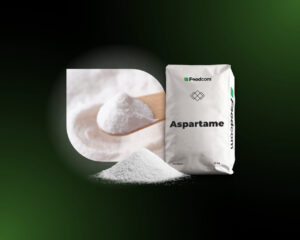- Aspartame (E951) is a popular sweetener, used as a sugar substitute.
- It has an intense sweetness (180-200 times sweeter than sugar) and is calorie-free.
- It is most commonly found in fizzy drinks, diet products and pharmaceuticals.
- Despite the controversy, it is considered safe for the majority of the population.
Aspartame is one of the most commonly used sweeteners, found in foods under the symbol E951. Due to its intense sweetness, it is used in a wide range of products, including fizzy drinks, chewing gum, desserts and diet products. With the growing popularity of sugar substitutes, it is worth taking a look at what aspartame is, how it works and where it is used, as well as what alternatives there may be to it.
Aspartame’s chemical composition and properties
Aspartame is a chemical compound from the peptide ester group, a combination of two amino acids – aspartic acid and phenylalanine – through a methyl group. It is an intensely sweet substance that is 180-200 times sweeter than traditional sugar (sucrose), but does not provide as many calories. Aspartame is a popular choice for people who want to reduce their sugar and calorie intake.
The substance comes in the form of a white crystalline powder. Aspartame has a slightly sweet taste similar to sugar, making it well tolerated by consumers. As it is extremely sweet, it can be used in small quantities, so the caloric impact of aspartame is negligible. In addition, it dissolves quite well in liquids with a reduced pH, making it ideal for use in acidic carbonated beverages.
However, it is worth bearing in mind that aspartame is not thermostable, meaning that it breaks down and loses its sweetening properties when exposed to high temperatures. Loss of sweetness can also occur in alkaline environments and when reacting with aldehyde flavouring compounds.
How does aspartame work?
Aspartame is an artificial sweetener. It imparts a sweet taste because it interacts with the sweet taste receptors on the tongue. However, aspartame consumption does not increase blood glucose levels or release insulin, making it a suitable choice for diabetics. It also does not raise cholesterol or triglyceride levels.
In the body, aspartame is broken down into aspartic acid, phenylalanine and a small amount of methanol. Phenylalanine is an amino acid that occurs naturally in many foods, but high concentrations can be harmful to people with phenylketonuria, a rare genetic disorder. Despite the long-standing controversy, aspartame and its breakdown products are perfectly safe for most of the population.
Use of aspartame in the food industry
Aspartame is widely used in the food industry, especially in the production of fizzy drinks and diet products. It is mainly used in ‘light’ and ‘zero’ drinks as a sugar substitute, so that these drinks retain an approximate taste with a significantly reduced number of calories. The sweetener aspartame is also added to chewing gums, candies, sugar-free desserts, yoghurts and even some medicines and dietary supplements.
Aspartame in the production of fizzy drinks
Carbonated drinks are one of the main segments of the food industry where aspartame is used. Its sweetness, ability to maintain flavour intensity and good solubility make it one of the preferred sweeteners in this type of product. Aspartame allows manufacturers to offer low-calorie alternatives to favourite beverages. Some products contain not only aspartame, but also blends of sweeteners, such as the addition of acesulfame, for a better taste profile and chemical stability.
Food products and aspartame
Aspartame is often used in products for people on low-calorie diets and diabetics. It can be found in products such as:
- diet yoghurts and desserts,
- chewing gum,
- sweets,
- cured meats and fish,
- flavoured mineral waters and isotonic drinks,
- diet energy drinks,
- flavoured beers.
Aspartame is also available in the form of lozenges for self-administration.
Aspartame and pharmacology
Aspartame is also found in pharmaceuticals, particularly over-the-counter medicines. For example, aspartame is found in effervescent vitamin tablets, sugar-free lozenges, syrups and cold powders.
Production and sale of aspartame
How is aspartame produced? The process involves the synthesis of two amino acids, phenylalanine and aspartic acid, which is possible through a chemical process or through biotechnological technologies. The process is controlled to ensure the purity and safety of the final product. Aspartame is a dipeptide that is formed by combining the above-mentioned amino acids. In order to obtain it, it is necessary to carry out a process of formal condensation of the alpha-carboxyl group of L-aspartic acid with the amino group of L-methyl phenylalanoate.
The price of aspartame can vary depending on the manufacturer, order volume and market conditions. In recent years, the price of aspartame has been relatively stable due to developments in production technology and increased demand. As it is used in small quantities, it is profitable for producers even with larger price fluctuations.
Aspartame has been known since 1965. The first manufacturer of this substance was G.D. Searle & Company, later acquired by Monstanto and then NutraSweet Company. Other well-known manufacturers of aspartame include Ajinomoto, Merisant and the Holland Sweetener Company. A trusted distributor of sweeteners on the international market is Foodcom S.A., which is committed to the highest quality, availability and competitive pricing of its products.
Alternatives to aspartame – natural food additives
Despite the popularity of aspartame, interest in natural sugar substitutes continues to grow. One such additive is xylitol, also known as birch sugar. Unlike aspartame, xylitol is thermostable and can be used for baking and cooking. It has a low glycaemic index, but does not match aspartame in terms of sweetness intensity – it is only about 20-30% sweeter than sugar.
Other natural food additives, such as stevia, erythritol or monk fruit, are gaining popularity due to their lack of calories and natural origins. However, each has its own advantages and disadvantages – stevia, for example, can have a bitter aftertaste, while erythritol in large quantities can cause stomach discomfort. Other sweetener options are also appearing on the market, such as sucralose or acesulfame K.
Aspartame is widely used in the food industry, especially in the production of fizzy drinks and diet products. Its intense sweetness and low calorie content make it a popular sweetener among weight watchers. With the growing interest in natural additives such as xylitol and stevia, aspartame remains at the forefront of sweeteners used in the food industry.











